| View previous topic :: View next topic |
| Author |
Message |
Kathmandu


Joined: 09 Dec 2009
Posts: 1479
Location: (Kathmandu,Nepal. Currently)Pacific Northwest, USA
Expire: 2012-04-08
|
 Posted: Thu Jul 28, 2011 10:06 pm Post subject: Care to comment? Posted: Thu Jul 28, 2011 10:06 pm Post subject: Care to comment? |
 |
|
Kathmandu wrote:
Since I have read very little on this lens on the web . I would love to hear of any your experiences with this lens, its usage ,performance, any literature would be a super. Its sitting in my home made infrared box as I saw a couple of fungus spots-which I can hopefully remove.
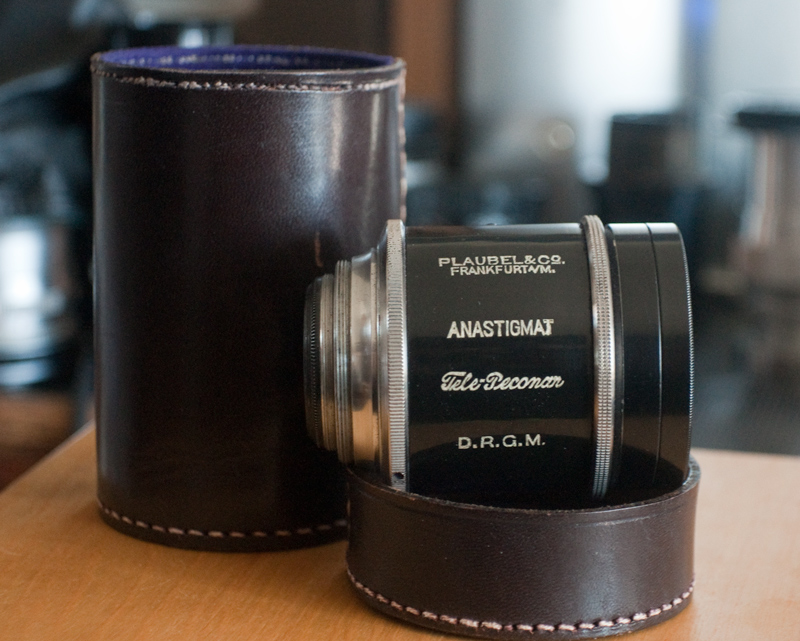
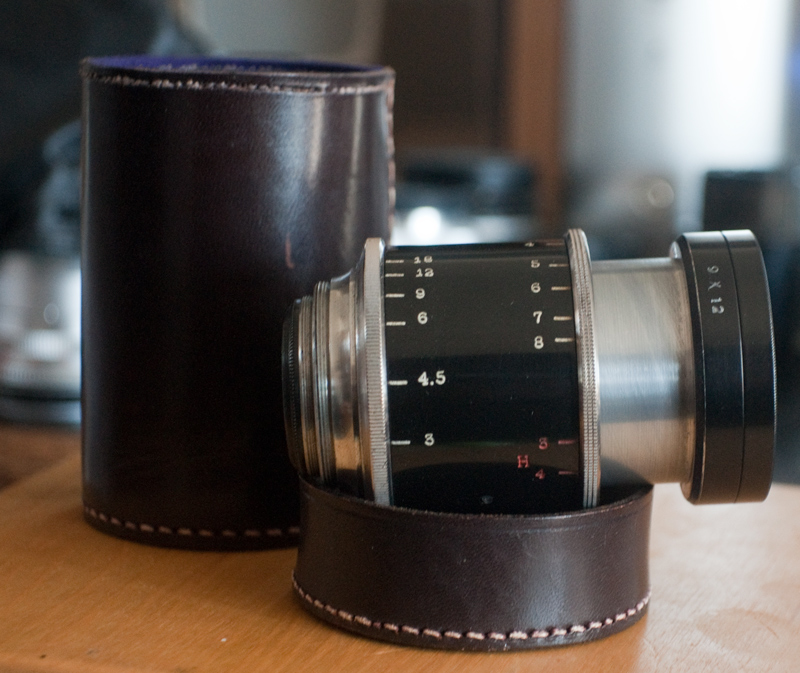
Hasta la vista
_________________
kathmandu
Sony α 700 DSLR
 |
|
| Back to top |
|
 |
Attila


Joined: 24 Feb 2007
Posts: 57865
Location: Hungary
Expire: 2025-11-18
|
 Posted: Thu Jul 28, 2011 10:36 pm Post subject: Posted: Thu Jul 28, 2011 10:36 pm Post subject: |
 |
|
Attila wrote:
Plaubel is a rare and usually expensive brand, not many people have it, I guess only the reason why you couldn't get much information . I am afraid you can't get much from here also. I remember Andy (F16Sunshine ) know Plaubel cameras.
_________________
-------------------------------
Items on sale on Ebay
Sony NEX-7 Carl Zeiss Planar 85mm f1.4, Minolta MD 35mm f1.8, Konica 135mm f2.5, Minolta MD 50mm f1.2, Minolta MD 250mm f5.6, Carl Zeiss Sonnar 180mm f2.8
|
|
| Back to top |
|
 |
Kathmandu


Joined: 09 Dec 2009
Posts: 1479
Location: (Kathmandu,Nepal. Currently)Pacific Northwest, USA
Expire: 2012-04-08
|
 Posted: Thu Jul 28, 2011 11:10 pm Post subject: Posted: Thu Jul 28, 2011 11:10 pm Post subject: |
 |
|
Kathmandu wrote:
| Attila wrote: |
| Plaubel is a rare and usually expensive brand, not many people have it, I guess only the reason why you couldn't get much information . I am afraid you can't get much from here also. I remember Andy (F16Sunshine ) know Plaubel cameras. |
I hope someone has some Sale brochures or literature. I will be cleaning it and testing it on my Sony Alpha 700, next week -so far it looks like it will mount easy on an adapter. I should be able to figure out its register distance etc, and weather its any good mounted on a DSLR.
I have lots of faith in the knowledge and experience of members here.

Cheers
_________________
kathmandu
Sony α 700 DSLR
 |
|
| Back to top |
|
 |
luisalegria


Joined: 07 Mar 2008
Posts: 6602
Location: San Francisco, USA
Expire: 2018-01-18
|
 Posted: Thu Jul 28, 2011 11:40 pm Post subject: Posted: Thu Jul 28, 2011 11:40 pm Post subject: |
 |
|
luisalegria wrote:
A very interesting lens indeed. You have quite a curiosity there !
See here -
http://www.syzygyst.com/JoePhoto/tpec/index.htm
This thing is basically a very early zoom lens. The first ring from the front "zooms", or rather shortens the focal length as the lens extends.
The lens seems to be designed to go into one of the standard Compur shutter threads. I suspect the 9x12 indicates coverage for this format. I'm guessing this thing may cover 4x5 with luck.
_________________
I like Pentax DSLR's, Exaktas, M42 bodies of all kinds, strange and cheap Japanese lenses, and am dabbling in medium format/Speed Graphic work. |
|
| Back to top |
|
 |
visualopsins


Joined: 05 Mar 2009
Posts: 10983
Location: California
Expire: 2025-04-11
|
 Posted: Thu Jul 28, 2011 11:45 pm Post subject: Posted: Thu Jul 28, 2011 11:45 pm Post subject: |
 |
|
visualopsins wrote:
Is that 9x12 seen on front of barrel? 9x12 was Euro standard, slightly smaller than 4x5". That's a BIG piece of film compared to 35mm! 
Hmmm, I misread the name as Reconar, thinking a telephoto lens (for reconnaissance?), but written is actually 'Peconar'. Google of 'tele-peconar' gives 1430 results...such as Tele-Peconar 3 for in-lens shutter & 3S for rear-of-lens shutter (both variable focal length) on 6x9 Makina camera page at camerapedia.
What is the lens focal length? 
_________________
☮☮☮☮☮☮☮☮☮☮☮☮☮☮☮☮☮☮☮☮☮☮☮☮☮☮☮☮☮☮☮☮ like attracts like! ☮☮☮☮☮☮☮☮☮☮☮☮☮☮☮☮☮☮☮☮☮☮☮☮☮☮☮☮☮☮☮☮
Cameras: Sony ILCE-7RM2, Spotmatics II, F, and ESII, Nikon P4
Lenses:
M42 Asahi Optical Co., Takumar 1:4 f=35mm, 1:2 f=58mm (Sonnar), 1:2.4 f=58mm (Heliar), 1:2.2 f=55mm (Gaussian), 1:2.8 f=105mm (Model I), 1:2.8/105 (Model II), 1:5.6/200, Tele-Takumar 1:5.6/200, 1:6.3/300, Macro-Takumar 1:4/50, Auto-Takumar 1:2.3 f=35, 1:1.8 f=55mm, 1:2.2 f=55mm, Super-TAKUMAR 1:3.5/28 (fat), 1:2/35 (Fat), 1:1.4/50 (8-element), Super-Multi-Coated Fisheye-TAKUMAR 1:4/17, Super-Multi-Coated TAKUMAR 1:4.5/20, 1:3.5/24, 1:3.5/28, 1:2/35, 1:3.5/35, 1:1.8/85, 1:1.9/85 1:2.8/105, 1:3.5/135, 1:2.5/135 (II), 1:4/150, 1:4/200, 1:4/300, 1:4.5/500, Super-Multi-Coated Macro-TAKUMAR 1:4/50, 1:4/100, Super-Multi-Coated Bellows-TAKUMAR 1:4/100, SMC TAKUMAR 1:1.4/50, 1:1.8/55
M42 Carl Zeiss Jena Flektogon 2.4/35
Contax Carl Zeiss Vario-Sonnar T* 28-70mm F3.5-4.5
Pentax K-mount SMC PENTAX-A ZOOM 1:3.5 35~105mm, SMC PENTAX ZOOM 1:4 45~125mm
Nikon Micro-NIKKOR-P-C Auto 1:3.5 f=55mm, NIKKOR-P Auto 105mm f/2.5 Pre-AI (Sonnar), Micro-NIKKOR 105mm 1:4 AI, NIKKOR AI-S 35-135mm f/3,5-4,5
Tamron SP 17mm f/3.5 (51B), Tamron SP 17mm f/3.5 (151B), SP 500mm f/8 (55BB), SP 70-210mm f/3.5 (19AH)
Vivitar 100mm 1:2.8 MC 1:1 Macro Telephoto (Kiron)
|
|
| Back to top |
|
 |
woodrim


Joined: 14 Jan 2010
Posts: 4060
Location: Charleston
|
 Posted: Fri Jul 29, 2011 1:34 am Post subject: Posted: Fri Jul 29, 2011 1:34 am Post subject: |
 |
|
woodrim wrote:
Cool, but seems to have an identity crisis with many names and an equal number of font types.
_________________
Regards,
Woodrim |
|
| Back to top |
|
 |
Kathmandu


Joined: 09 Dec 2009
Posts: 1479
Location: (Kathmandu,Nepal. Currently)Pacific Northwest, USA
Expire: 2012-04-08
|
 Posted: Fri Jul 29, 2011 4:06 am Post subject: Posted: Fri Jul 29, 2011 4:06 am Post subject: |
 |
|
Kathmandu wrote:
| luisalegria wrote: |
A very interesting lens indeed. You have quite a curiosity there !
See here -
http://www.syzygyst.com/JoePhoto/tpec/index.htm
This thing is basically a very early zoom lens. The first ring from the front "zooms", or rather shortens the focal length as the lens extends.
The lens seems to be designed to go into one of the standard Compur shutter threads. I suspect the 9x12 indicates coverage for this format. I'm guessing this thing may cover 4x5 with luck. |
I saw that page too,before I got the lens -looks like thats the most extensive info. there is on the web.I found the test images there are hard to make out.
| visualopsins wrote: |
Is that 9x12 seen on front of barrel? 9x12 was Euro standard, slightly smaller than 4x5". That's a BIG piece of film compared to 35mm!
Hmmm, I misread the name as Reconar, thinking a telephoto lens (for reconnaissance?), but written is actually 'Peconar'. Google of 'tele-peconar' gives 1430 results...such as Tele-Peconar 3 for in-lens shutter & 3S for rear-of-lens shutter (both variable focal length) on 6x9 Makina camera page at camerapedia.
What is the lens focal length? |
I'll have to read camerapedia some more. If you follow the link Luis has -the lens I now own is the second one there, with the "Red H"
| woodrim wrote: |
| Cool, but seems to have an identity crisis with many names and an equal number of font types. |
Thats exactly what we're trying to figure out,more info on the lens. I personally like the fonts. 
Best
_________________
kathmandu
Sony α 700 DSLR
 |
|
| Back to top |
|
 |
Kathmandu


Joined: 09 Dec 2009
Posts: 1479
Location: (Kathmandu,Nepal. Currently)Pacific Northwest, USA
Expire: 2012-04-08
|
 Posted: Sat Jul 30, 2011 1:56 am Post subject: Posted: Sat Jul 30, 2011 1:56 am Post subject: |
 |
|
Kathmandu wrote:
I cleaned the fungus today and the glass is very clean and clear. I mounted it on bellows and confirmed John's research -the lens is 200mm approx all out and close to 600mm all in.
Even when I get a focus on objects ,the images are real crappy, and lacks contrast.
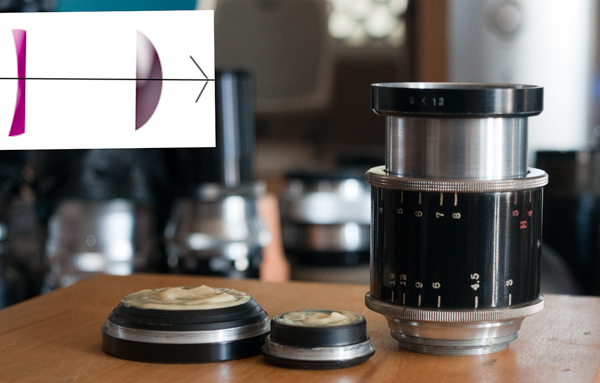
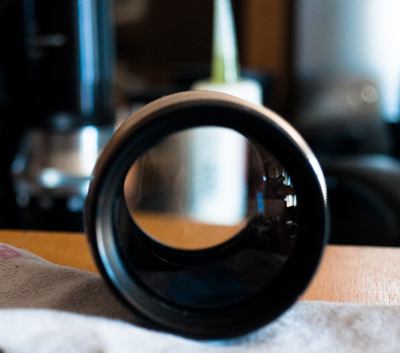 
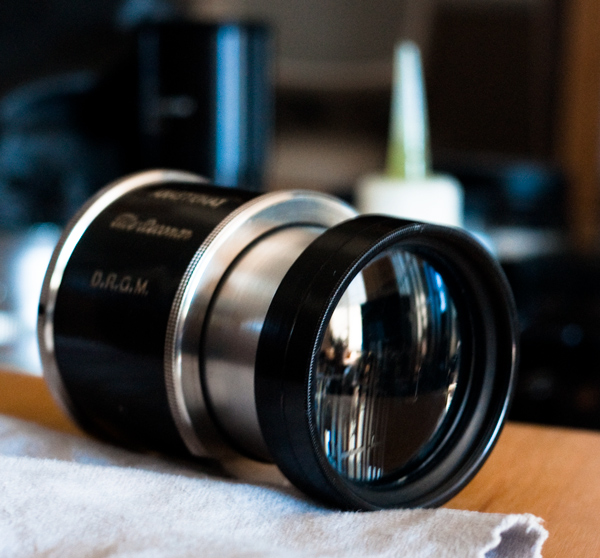
The lens design is gaussian(1817 AD) with a large gap between the elements. When I look through the lens with my naked eyes images appear crystal clear.
Thats all I have for now on this Tele-Peconar. I am starting to think maybe it was supposed to be used with a second tube with lenses. John from the link that Luis provided above has done a very thorough job , but he adds that he did not know much about lens was -since there was so little information on the web.
I did see a Tele-Pecor on German ebay and there was literature in German with it. It would be awesome to get hold of a sales advertisement or manual like that. Untill then its a very nice magnifyer,and conversation piece. Also curious if theres anything in the Lens Vade Mecum?
Thanks  
_________________
kathmandu
Sony α 700 DSLR
 |
|
| Back to top |
|
 |
luisalegria


Joined: 07 Mar 2008
Posts: 6602
Location: San Francisco, USA
Expire: 2018-01-18
|
 Posted: Wed Apr 18, 2012 8:38 am Post subject: Posted: Wed Apr 18, 2012 8:38 am Post subject: |
 |
|
luisalegria wrote:
I just bought one of these. Not as nice as yours but the markings match, so its probably the same specification.
I have Speed Graphics so I will probably be able to give it a try as it should have been used. I also have lots of Compur shutters.
I also suspect this was meant to go into an already mounted shutter, replacing one or both of the lens cells on one of the typical German plate cameras. The better 9x12 ones with a double extension bellows can extend further than a Speed Graphic.
_________________
I like Pentax DSLR's, Exaktas, M42 bodies of all kinds, strange and cheap Japanese lenses, and am dabbling in medium format/Speed Graphic work. |
|
| Back to top |
|
 |
luisalegria


Joined: 07 Mar 2008
Posts: 6602
Location: San Francisco, USA
Expire: 2018-01-18
|
 Posted: Wed Apr 18, 2012 8:57 am Post subject: Posted: Wed Apr 18, 2012 8:57 am Post subject: |
 |
|
luisalegria wrote:
This guy has the secret -
http://richmond-seikatsu.seesaa.net/category/9444874-1.html
In Japanese, but clear enough -
This thing goes on the Plaubel Makina - a 6.5x9 format rangefinder press camera of the time.
IIRC the Makina of some models had front-mounted lenses - the shutter blades were behind the lens - so one just screws lenses into the shutter. So this is a proper screw mount lens, its just a Plaubel thread, whatever that is.
It looks like the Plaubel Makina had bellows extension backs (with groundglass I suppose) that permitted the use of the full focal length.
_________________
I like Pentax DSLR's, Exaktas, M42 bodies of all kinds, strange and cheap Japanese lenses, and am dabbling in medium format/Speed Graphic work. |
|
| Back to top |
|
 |
Lightshow


Joined: 04 Nov 2011
Posts: 3666
Location: Calgary
|
 Posted: Thu Apr 19, 2012 10:03 am Post subject: Re: Care to comment? Posted: Thu Apr 19, 2012 10:03 am Post subject: Re: Care to comment? |
 |
|
Lightshow wrote:
| Kathmandu wrote: |
Its sitting in my home made infrared box as I saw a couple of fungus spots-which I can hopefully remove.
|
Correction, UV not IR.
_________________
A Manual Focus Junky...
One photographers junk lens is an artists favorite tool.
My lens list
http://www.flickr.com/photos/lightshow-photography/ |
|
| Back to top |
|
 |
Gurdie


Joined: 29 Jul 2008
Posts: 997
Location: Finland
Expire: 2013-02-20
|
 Posted: Thu Apr 19, 2012 3:45 pm Post subject: Posted: Thu Apr 19, 2012 3:45 pm Post subject: |
 |
|
Gurdie wrote:
I found the picture of your lens in my copy of "Photography Guide" (in Finnish), written by E.Piirinen, printed in 1928 (first edition 1920).
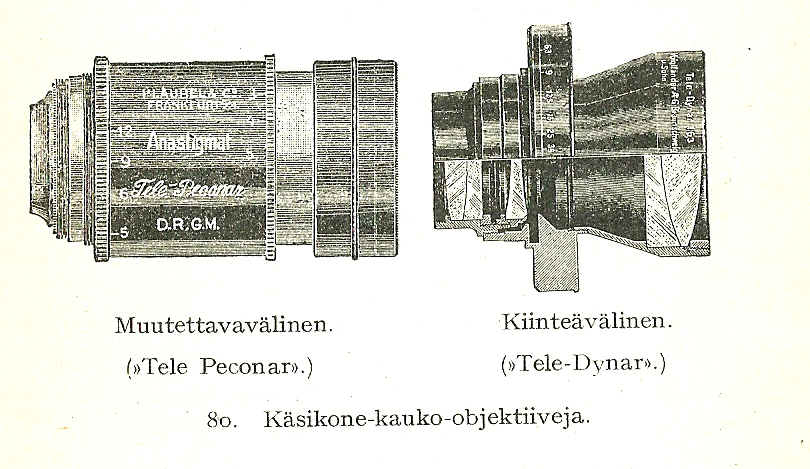
The text only says, that there are both fixed FL and variable FL tele lenses, and the examples shown are Tele Peconar and Tele-Dynar.
_________________
Markku
Give me two hours a day of activity, and I'll take the other twenty-two in dreams.
― Salvador Dali
----------------------------------------- |
|
| Back to top |
|
 |
Nesster


Joined: 24 Apr 2008
Posts: 5883
Location: NJ, USA
Expire: 2014-02-20
|
 Posted: Thu Apr 19, 2012 4:33 pm Post subject: Posted: Thu Apr 19, 2012 4:33 pm Post subject: |
 |
|
Nesster wrote:
I just saw one owned by one of my flickr friends:
http://www.flickr.com/photos/8056279@N05/7089071291/
_________________
-Jussi
Camera photos
Print Photographica
|
|
| Back to top |
|
 |
Olivier


Joined: 18 Feb 2009
Posts: 5078
Location: France
Expire: 2015-08-06
|
 Posted: Thu Apr 19, 2012 8:56 pm Post subject: Posted: Thu Apr 19, 2012 8:56 pm Post subject: |
 |
|
Olivier wrote:
A page from encyclopedic treatise photography charles Fabre 1889 Paris
http://www.suaudeau.eu/memo/Fabre/fabre_objo/fabre_objo_D/119.html
I try to traduct from french to english. google is not always a good friend for that...
The Télé-Péconar of Plaubel & Co., Frankfurt, consists of a combination of three positive lenses, well corrected for all aberrations and a negative plane concave combination of two lenses ; they are attached to two tubes sliding one in the other so as to allow the variation in distance between the two lenses: the distance between the lenses adjusts the magnification ; the more they are close to each other, the more the image is magnified and vice versa. The front combination has an opening diameter of 31mm for a 70mm focal length. The flatness of field and the destruction of the spherical aberration are obtained by using a crown of very high refractive index: the positive lens is very well corrected, allowing high magnifications.
The Tele-Péconar can be used in two ways : 1°) it can be screwed by its back instead of the anterior lens of ordinary doublets : it is the way of using it which must be used for cameras with fixed plans ; the posterior lens of the doublet remains in place: 2°) unscrew this rear lens, the Télé-Péconar being in place, the instrument works now as an ordinary telephoto lens and the magnification is stronger.
These magnifications are, moreover, indicated by two scales with tick marks correspond to the two ways of use that we have just indicated. If using a darkroom bellows, it is good to print on the basis of the room cues corresponding to the sequence from each of the scales. For focusing, one always uses the diaphragm to be used when printing of the plate. For portrait, f/9 is used, while for landscape it is f/18.
Relative aperture gives the duration of the exposure time, we calculate the relative aperture of a telephoto system by dividing the aperture of the diaph used by the magnification figure.
_________________
Olivier - Moderator 
Dslr : Olympus Pen E-P2 - Fujifilm X-Pro2 - Canon 5D MkII.
SLr and MF lenses : for feedback and helping people, cameras and lenses I own : full list here http://forum.mflenses.com/viewtopic,p,1442740.html#1442740 |
|
| Back to top |
|
 |
|
|
|
You cannot post new topics in this forum
You cannot reply to topics in this forum
You cannot edit your posts in this forum
You cannot delete your posts in this forum
You cannot vote in polls in this forum
|
